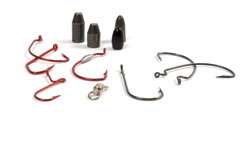
Take a look at any of the Bassmaster Magazines from the early days, and it's immediately apparent that much of the tackle being used seems painfully outdated: heavy fiberglass rods, reels having no ball bearings and fishing lines thick as the frames on horn-rimmed reading glasses.
What a difference 40 years makes. Now, anglers fish with reels having 12 or more ball bearings, rods weighing less than 3 ounces and translucent braids. Terminal tackle, too, has seen its share of innovations in the last four decades.
Whereas the bass anglers of yesteryear had no choice but to deal with a small selection of hooks and unpainted lead sinkers, today's hooks, sinkers and assorted terminal tackle offerings are unrecognizable when compared to the products that came before them.
Here are five of the biggest terminal tackle innovations of the last 40 years.
1. TUNGSTEN SINKERS
With all due respect to the fine companies still creating quality lead sinkers, in the last five years tungsten sinkers have taken the sinker market from stale to exciting. In contrast to lead sinkers, which are at least 25 percent larger, tungsten's added density makes sinkers far more sensitive. But possibly most important, the smaller size allows anglers to get away with fishing a heavier sinker but without the added bulk. For example, theaverage 1-ounce lead sinker is nearly twice the size of the average 1-ounce tungsten sinker. It's not an overstatement to say that tungsten has forever changed bass fishing.
2. OFFSET SHANK/WIDE GAP HOOKS
Before the advent of offset worm hooks, anglers were commonly frustrated by having their plastics slide down the shank of their straight shank worm hooks — the most popular style until the late 1980s. But with the introduction of the offset round bend and offset O'Shaughnessy bend hooks, anglers had a hook that would keep plastics in place, even when fished in cover such as grass and wood. For years, the offset round bends dominated the bass market, becoming the first choice for anglers fishing ribbontail worms, straight-tail worms, finesse worms, lizards and soft plastic stickbaits. In the 1990s, however, fat-bodied creature baits were gaining popularity, and with their arrival came a new problem: how to find an offset hook that would hold a lure in place but have a wide enough gap to account for the bait's bulk. Offset wide gaps from companies such as Gamakatsu, makers of the famously popular EWG (Extra Wide Gap), Mustad (Mega Bite), Daiichi (Fat Gap) and Eagle Claw (Wide Gap) have largely solved those problems. The newest breed of wide gaps come in both heavy wire and light wire, sizes up to 12/0 and can account for even the bulkiest creature baits. In recent years, wide gaps have become the best selling bass hooks on the market, the result of more and more bass anglers moving away from straight shank hooks altogether and going over to wide gaps as a great all-around choice for soft plastics.
3. CHEMICALLY SHARPENED HOOKS
Before the mid-1980s, it was common for bass anglers to purchase a 100-pack of their favorite worm hooks and then spend hours sharpening them before the next outing.And after sharpening the hooks began the time-consuming (and very tedious) task of applying clear coat paint or fingernail polish to each point to prevent rusting. The Eagle Claw Lazer Sharp chemically sharpened hooks, introduced in 1985, made this entire process unecessary. The hooks, available in an array of bass fishing styles, came sharp out of the box. What's more, the hooks had a very strong point, which would not flex or break off during hook sets or prolonged fighting with large fish. Today, just about any company creating a respectable bass hook has them chemically sharpened. The chemicals used to treat hooks eat away at the thinner sections — that is, the point — creating a point that is smooth, sharp and stronger than anything available to anglers decades ago. "It used to be that when you interviewed BASS anglers, all of them would say they sharpen their hooks," says Ken Duke, senior editor for Bassmaster. "Now, I doubt you could find any angler who says he sharpens his hooks. There's no need to."
4. RED HOOKS
TTI-Blakemore's introduction of Bleeding Bait Hooks in 1999 opened a door in the hook market that had never existed. Previously, hooks came in gold, bronze, black nickel or similar metallic colors. But these hooks, with a bright red finish, quickly began showing up in bass anglers' tackleboxes. Selling consumers on the concept that the red hooks promoted a feeding response from predatory fish such as largemouth, the company reaped the rewards early on by being the only player in the category, with Bleeding Bait trebles, worm hooks and circle hooks being all the rage for years after their introduction. It wasn't long, though, before just about every company had its own red hook. In fact, it's now safe to say that any company that makes hooks offers at least one model in red, the product of frequent requests from bass anglers. "What we started nearly 10 years ago has just taken off," says T.J. Stallings, spokesman for TTI-Blakemore.
5. BALL BEARING SWIVELS
Though ball bearing swivels have been around since the 1940s, when they were created by inventor Oney Johnson, it's only been in the last 25 years or so that they've been widely used in bass fishing. Today, it's a good bet you won't pick up a quality spinnerbait without a ball bearing swivel. And with bass fishermen growing more and more sophisticated in their tackle choices in the 1980s and 1990s, spinnerbait companies began using the phrase "contains ball bearing swivels" as a means of setting their product apart from the less expensive offerings that did not use ball bearing swivels. In fact, many spinnerbait companies advertise the fact that the product contains a Sampo ball bearing swivel — the most popular premium brand — right on the package. In recent years, a number of companies have brought ball bearing swivels to market, forcing the popular crane-style swivels to take even more of a back seat. (Many anglers still purchase inexpensive crane swivels to use with Carolina rigs.) Today, however, ball bearing swivels are hugely popular for everything from joining braid to mono and preventing line twist when fishing soft plastic jerkbaits to fishing drop shots.





